At SlamHunt, we provide a comprehensive and categorized hunting species list to help you explore the world’s most iconic game animals across multiple continents. Whether you’re planning a trophy hunt, pursuing an official slam, or seeking exotic wildlife for a once-in-a-lifetime expedition, our species directory is designed to support your goals. Discover which species are available, where they can be hunted legally with professional outfitters, and how each contributes to structured hunting achievements. Navigate by region, species type, or hunter profile, and track your progress as you move through your personal or official slam hunting challenges.
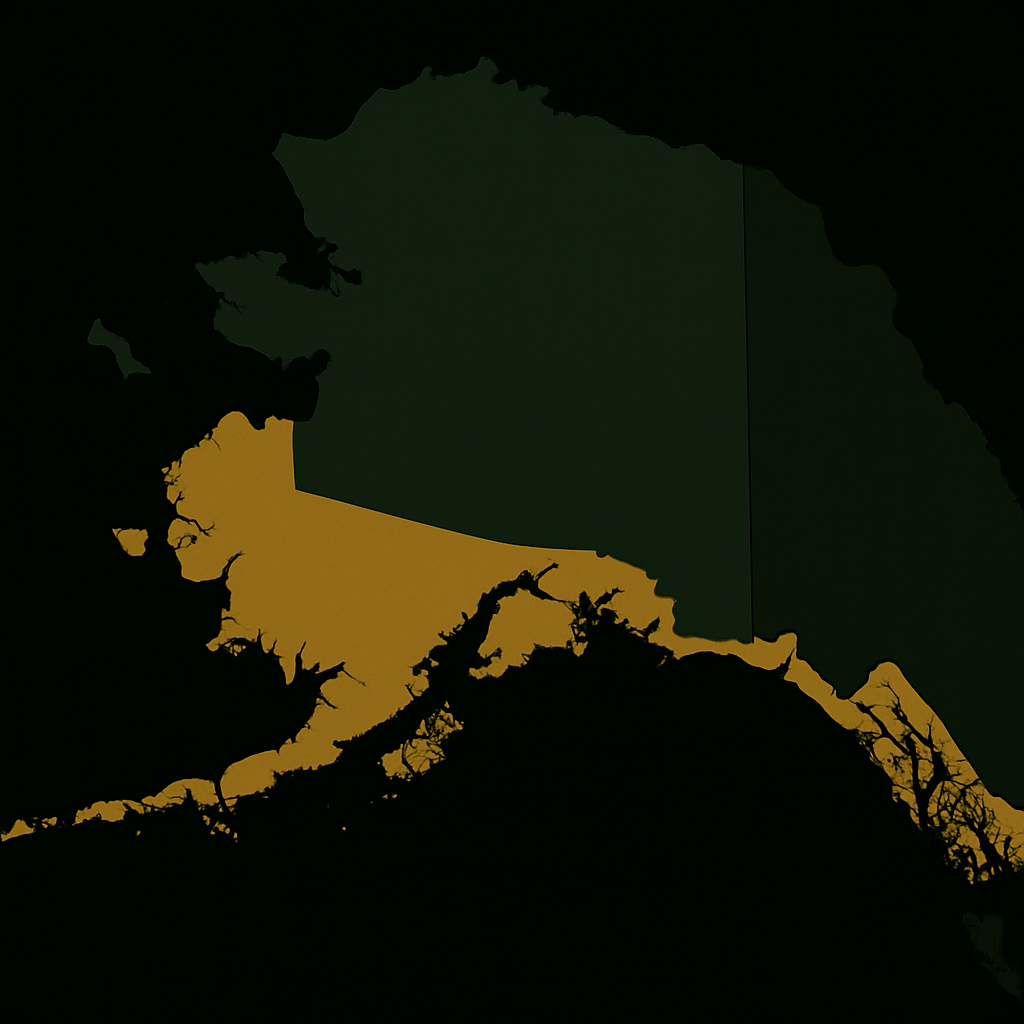
Alaska & Northern Wilderness represents one of the most iconic and demanding regions in the global hunting landscape. Characterized by vast tundras, rugged mountains, and extreme remoteness, it offers access to legendary big game hunting species.
This region is essential for hunters pursuing the North American Grand Slam, the Ovis World Slam, or other structured slam hunting achievements. With unmatched biodiversity and the need for specialized logistics. These species not only define Alaska’s wild landscape, but also play a central role in the most ambitious hunting achievements:
One of Alaska’s most formidable predators, known for its size, strength, and elusive behavior. Grizzly bear hunting is a high-difficulty pursuit that demands endurance and expert guidance.
The largest moose subspecies in the world. With antlers that can span over six feet, this animal is a top priority for big game hunters.
A high-altitude trophy that requires steep alpine climbs and careful glassing. Core species in both the North American Grand Slam and the Ovis World Slam.
Found in rugged mountain terrain, mountain goats present a vertical hunting challenge. Their elusive nature and the terrain they inhabit make them a favorite among mountain hunters.
Alaska is home to multiple migratory herds. Caribou hunts are often part of multi-species expeditions and are essential to several North American slam combinations.
Intelligent and ghostlike, wolves are rarely seen twice in the same spot. Hunts often involve extreme patience, snow tracking, and predator calling.
Widespread throughout Alaska’s forests and river corridors. Black bears are a popular target in spring and fall, especially in combo hunts with moose or caribou.
While Alaska is known for its iconic big game trophies, the region also offers a variety of secondary and complementary game species that enrich the overall hunting experience. These animals are often included in multi-species packages or targeted independently by hunters seeking a complete Alaskan expedition. From coastal wetlands to alpine brush, these species present diverse challenges and rewarding opportunities.
A popular upland bird species found in tundra and alpine zones. Commonly hunted on foot or in combination with mountain game expeditions.
Abundant in forested areas, especially in winter. Often targeted as part of predator-prey ecosystem hunts or small game experiences.
Alaska’s river deltas and coastal flats host large flocks of migratory birds. Waterfowl hunting is most active in the fall and provides exciting action for shotgun hunters.
Native to Kodiak Island and the southeastern archipelago. These coastal deer offer a remote hunting experience and are accessible mainly by boat or floatplane.
Occasionally hunted in tundra or forested areas. While not common targets, they’re sometimes included in predator-focused hunts.
Present in interior Alaska, though less commonly pursued. Can be taken opportunistically during wolf or bear hunts.
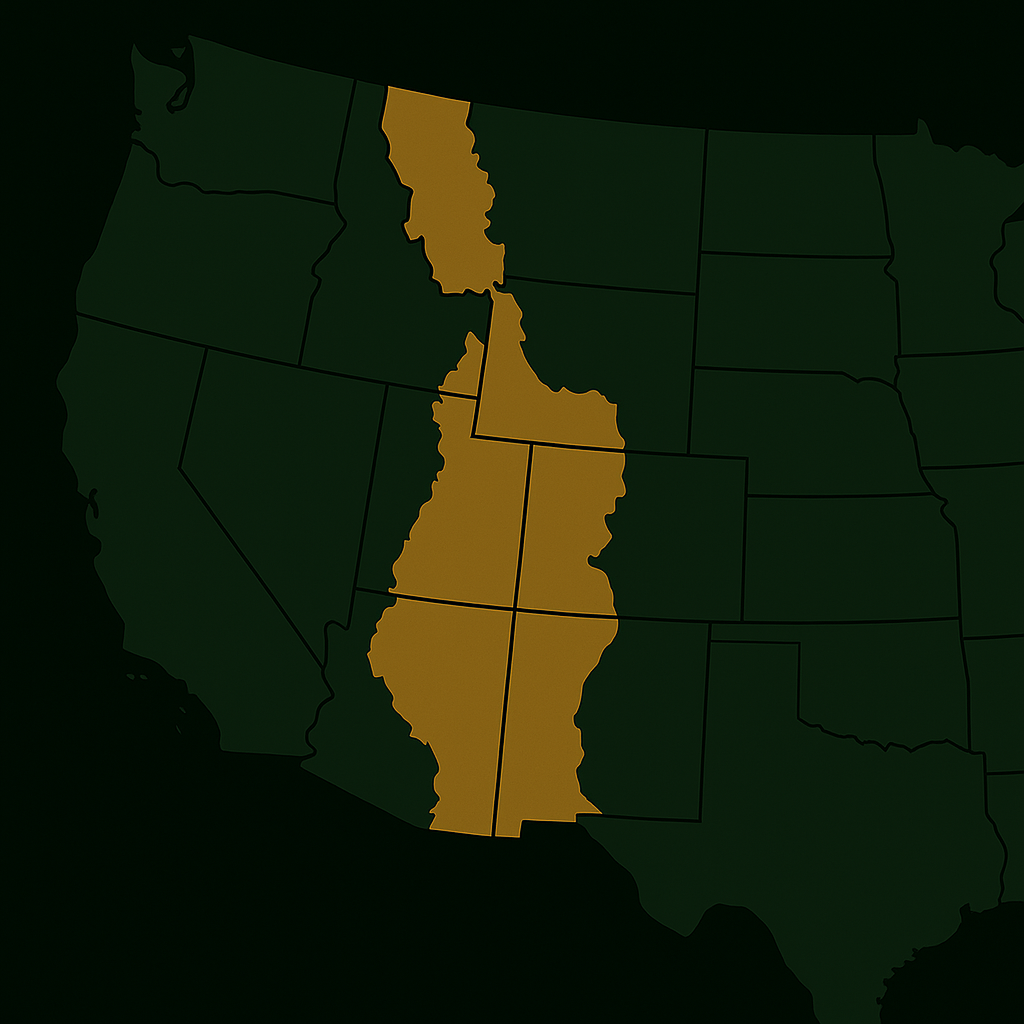
The Rocky Mountains cover a wide and diverse hunting zone across states like Montana, Colorado, Idaho, Wyoming, and Utah. This territory offers excellent access to huntable species ranging from rugged alpine dwellers to elusive forest predators. Great experience!
The Rocky Mountains are a cornerstone of western North American hunting, offering access to some of the most recognized trophy species in the continent. From high-elevation ridgelines to dense evergreen basins, this region hosts a diverse selection of huntable game animals that frequently appear in official slam species lists. These big game targets represent both physical challenge and trophy quality, making them essential for hunters tracking their slam progress or planning premium multi-species expeditions.
One of the most iconic species in the Rockies, elk are known for their loud bugling, herd dynamics, and seasonal rut activity. Highly sought after for their size and behavior, they’re a prime target in both general tags and trophy-specific hunts.
Well adapted to high-altitude terrain and dry climates, mule deer are known for their forked antlers and exceptional eyesight. Their elusive movements and mountain ranges make them a core pursuit for serious western hunters.
Though more common in eastern states, whitetail deer have strong populations in lower valleys and forest edges of the Rockies. They offer contrasting behavior to mule deer and are often included in combo hunts.
A symbol of alpine pursuit, bighorn sheep require physical endurance, precise glassing, and deep backcountry access. Considered a pinnacle trophy for North American hunters.
Common across forested slopes and berry-rich basins. Spring and fall hunts are most productive, with some areas offering spot-and-stalk or baited methods depending on local regulations.
Stealthy, territorial, and largely nocturnal, mountain lions in the Rockies are typically pursued with tracking hounds. Success requires snow, patience, and expert guides.
The Shiras moose, a smaller subspecies than Alaska-Yukon, is present in select valleys of Utah, Wyoming, and Colorado. Tags are limited and demand is high due to trophy quality and rarity.
Present in northern ranges of Montana and Idaho. Wolf hunting requires advanced tactics like predator calling or snow tracking, and is often conducted in combination with other hunts.
In addition to its celebrated trophy animals, the Rocky Mountain region is home to a variety of complementary and small game species that enhance the diversity of any hunting expedition. These animals are frequently included in **multi-species hunting combos**, or pursued individually by hunters focused on tags, seasons, or predator control. Their presence reinforces the Rockies as a versatile region for both big game and specialized hunts.
Common across forested foothills and open pine zones, this turkey subspecies is pursued during spring and fall seasons. Recognized for its white-tipped tail feathers, it’s often part of a Grand Slam in wild turkey hunting.
Though more abundant in the plains, pronghorns inhabit open basins in states like Wyoming and Colorado. Fast and sharp-eyed, they require glassing and long-range precision.
Abundant throughout the Rockies, especially in transitional habitat between forests and grasslands. Often hunted for predator management, usually with calls or opportunistically during other hunts.
Found in higher elevations and meadows, red foxes are typically taken as bonus predators when encountered. They’re not a primary target but are occasionally pursued by varmint hunters.
Present in alpine and forest zones with heavy snowfall. Known for their seasonal white coats, they’re often hunted by tracking in snow or as part of predator-prey ecosystem trips.
Native to mountain forests, this upland bird offers a challenge for shotgun hunters. Typically pursued during early fall and often encountered during big game scouting trips.
Lakes, rivers, and agricultural transitions host migratory birds during the fall. Duck and goose hunting adds variety to Rocky Mountain hunts, especially for combo itineraries.
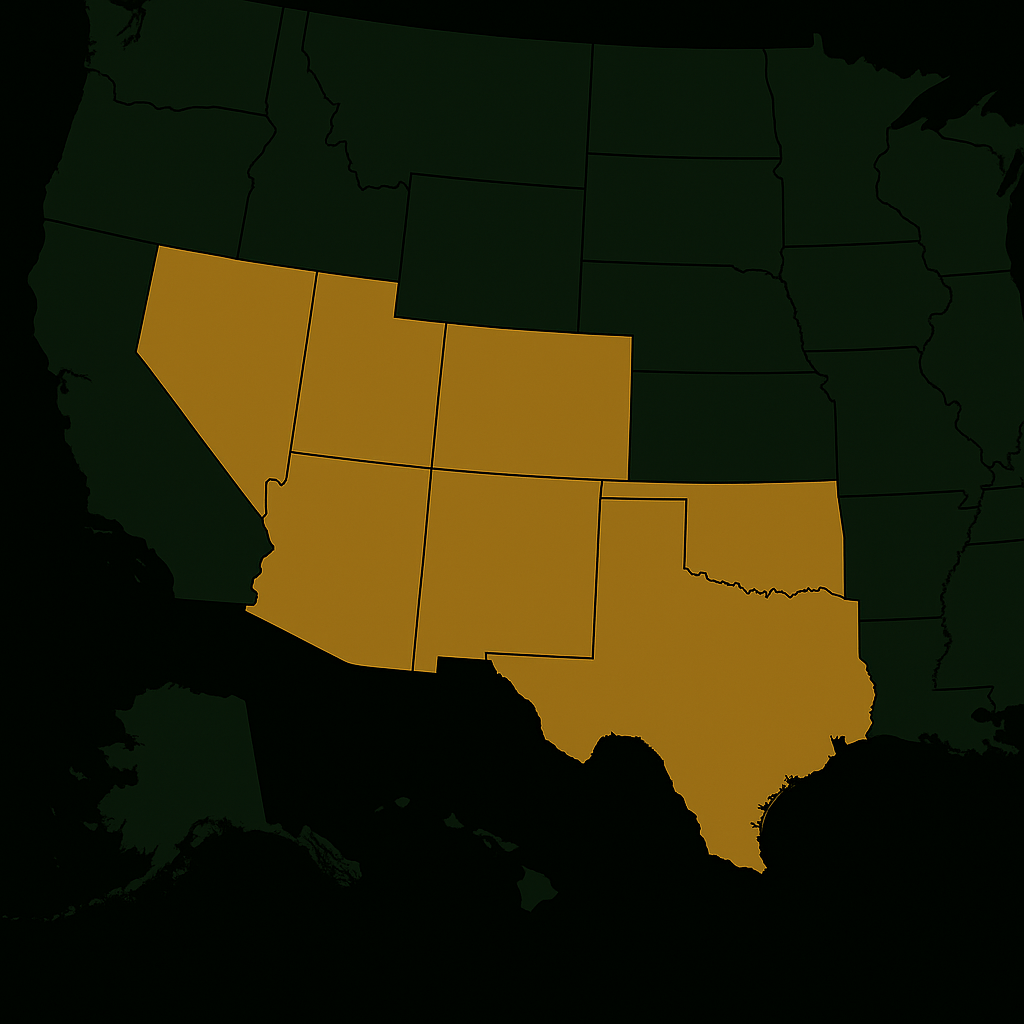
The American Southwest and desert regions offer a unique hunting experience defined by arid landscapes, dramatic elevations, and resilient wildlife. This zone is home to iconic species that thrive in harsh, dry environments—many of which are essential for desert-focused hunting slams and prized by collectors seeking rare trophy-class animals.
The Southwest is one of the most challenging and rewarding regions for desert hunting in North America. With its steep mesas, sparse vegetation, and rugged terrain, this environment is ideal for those seeking specialized terrain and true trophy-class animals. Many of these species are key components of regional hunting slams, and require patience, spot-and-stalk tactics, and deep knowledge of hunting in arid environments. Whether you’re targeting classic icons or rare desert dwellers, this region offers some of the most distinct and sought-after southwest hunting species available.
Originally from North Africa, Aoudad have adapted seamlessly to the desert cliffs and canyon systems of Texas and New Mexico. These wild sheep are elusive, tough, and require precision glassing and elevation gain. They’re a cornerstone species in desert-focused slams.
Known as the “Grey Ghost,” this subspecies of whitetail deer is small, alert, and extremely difficult to hunt. Found primarily in Arizona and parts of New Mexico, Coues hunts involve long hours of glassing and patient stalking across rocky foothills.
Common throughout the desert plateau and high-desert zones, mule deer in this region are known for their wide antler spreads and adaptability to dry, open terrain. They’re a foundational species for multi-species hunts in the Southwest.
Not technically a pig, but a collared peccary, javelina are abundant in desert scrublands and thorn brush. Though small, they offer a thrilling spot-and-stalk hunt and are often added as combo opportunities during other big game hunts.
Highly prized and extremely limited, desert bighorns inhabit the steepest and most remote desert ranges in Arizona, Nevada, and Texas. Tags are scarce and highly competitive, making them one of the most exclusive trophies in North America.
Often underestimated in this region, mountain lions thrive in arid, rocky canyons and desert mountain ranges. They are primarily hunted using hounds and are part of predator-control initiatives and multi-species pursuits.
Synonymous with javelina in the Southwest, these animals play a unique cultural and ecological role in desert hunting, offering exciting action for short-range hunters.
Across the American Southwest, a wide range of small game and upland species thrive in dry grasslands, rugged scrublands, and high-desert plateaus. These animals offer fast-paced, tactical hunts that complement the region’s trophy pursuits. Whether you’re chasing coveys of quail, walking canyons for rabbits, or glassing for migratory doves, the game diversity in arid environments creates year-round opportunities. These species are especially popular among shotgun hunters, youth hunts, and those seeking lightweight action in specialized terrain across the Southwest.
This iconic upland bird thrives in desert washes and thorn scrub. Recognizable by its topknot plume, Gambel’s quail flush in tight groups, offering exciting fast-action shooting. Found abundantly in Arizona, New Mexico, and West Texas.
Also known as “blue quail,” this ground-dwelling species prefers open prairies and desert grasslands. Their explosive flushes and rapid movements make them a favorite among seasoned upland hunters.
A common small game species across the Southwest’s brushy canyons and mesquite thickets. Popular in youth hunts and small-caliber outings, especially in winter and early spring seasons.
Larger than the cottontail, jackrabbits inhabit open country and can be hunted with shotguns or small-caliber rifles. Their bursts of speed and evasiveness make them surprisingly challenging.
A staple of early fall hunts, mourning doves migrate across the region in large numbers. Often hunted over grain fields and water sources, they offer accessible and social hunting experiences.
An invasive species that can be hunted year-round in most states without limit. Found near agricultural zones, towns, and water tanks, they add volume and action to any bird hunt.
Nicknamed the “ribeye of the sky,” sandhill cranes are hunted in select areas of Texas and New Mexico. Their large size and wary behavior make them a prized target during open seasons.
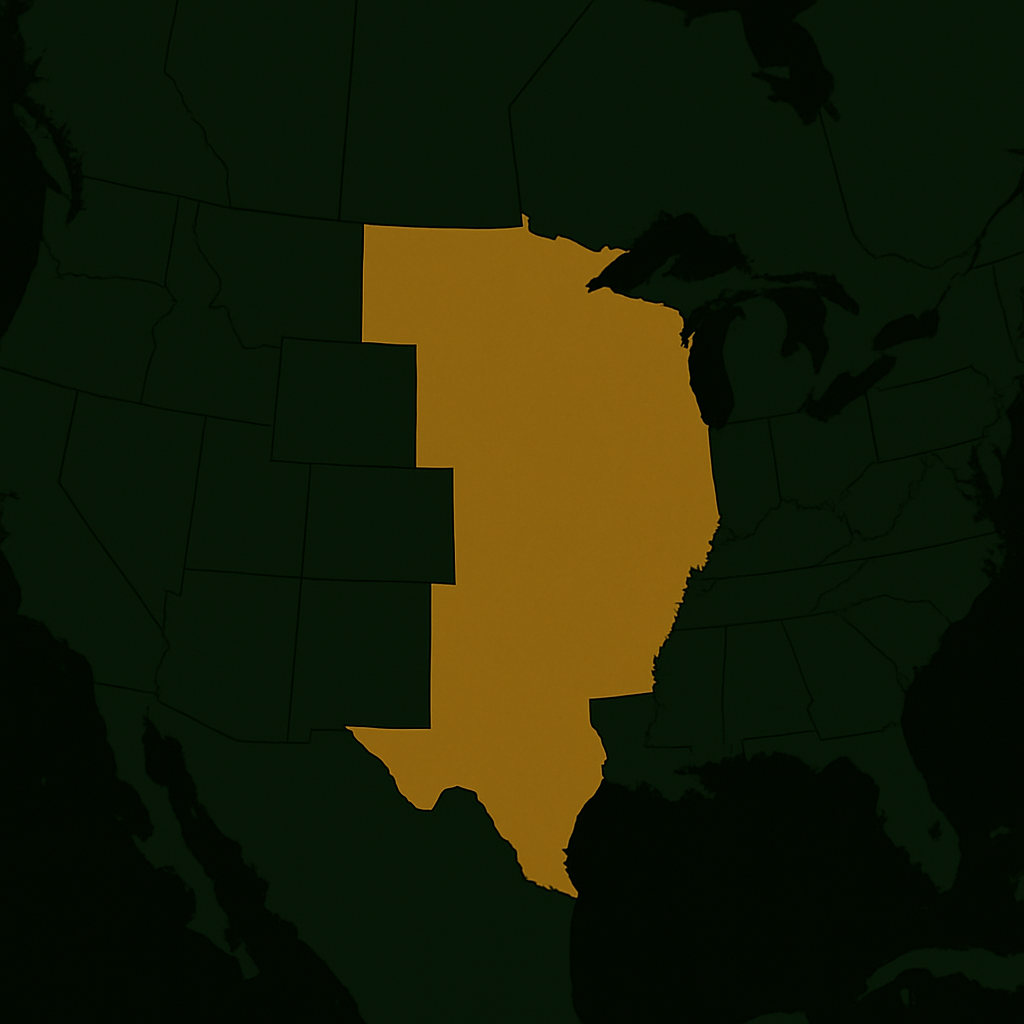
Spanning the heartland of North America, the Central Plains and prairie regions offer fertile ground for some of the most accessible and diverse game hunting in the continent. Characterized by open grasslands, rolling hills, and agricultural zones, these habitats support abundant populations of both big game and upland bird species, making them a strategic destination for recreational and slam-focused hunters alike.
Open prairies, river valleys, and agricultural belts across the Central Plains support a high concentration of huntable species, offering both opportunity and variety for traveling hunters. From the classic whitetail deer and pronghorn antelope to thriving populations of wild turkey and pheasant, this region delivers some of the most consistent success rates in North America. The diverse topography and accessible terrain make it ideal for both beginner and experienced hunters pursuing plains game or working toward broader hunting achievements.
Arguably the most pursued big game species in North America, whitetail deer thrive in the woodlots, cornfields, and river corridors of the Central Plains. With generous tag availability and excellent outfitter access, this species anchors most fall hunting seasons in the region.
Present in western sections of Nebraska and the Dakotas, mule deer offer a different challenge from their whitetail counterparts. Known for their bounding gait and preference for open country, they’re typically found in grassland breaks and upland ridges.
The Central Plains host strong populations of pronghorn, particularly in western Kansas and Nebraska. Spot-and-stalk tactics dominate in this terrain, where long-range visibility and wind management are crucial to success.
Spring turkey hunts are a major draw across the prairies, with both Eastern and Rio Grande subspecies available depending on the state. Turkeys thrive in riparian corridors, pasturelands, and woodland fringes, offering responsive calling action.
Synonymous with Midwestern upland hunting, ring-necked pheasants are abundant in CRP lands, grain fields, and fence rows. Kansas, South Dakota, and Nebraska are top destinations, known for their high bird numbers and walk-in access programs.
Once in decline, populations of greater prairie chickens have rebounded in select prairie ecosystems. These birds favor native grasslands and are a prized challenge due to their skittish behavior and sharp eyesight.
Primarily found in the northern plains and transitional habitats, sharp-tailed grouse are early-season upland targets. They’re known for quick takeoffs and broad ranging movements through sagebrush and shortgrass prairie.
This migratory species uses the Central Flyway as a key wintering route, especially in Nebraska, Kansas, and Oklahoma. Field hunting over decoys is the most common tactic, often yielding large-volume days.
Known for their massive flocks and aerial spectacle, snow geese offer some of the most exciting waterfowl hunts in the plains. Spring conservation seasons allow for liberal limits, extended hunts, and fast-paced shooting.
Beyond headline big game, the Central Plains support a wide array of small game and supporting huntable species that provide year-round opportunities across open farmland, brushy edges, and riparian corridors. From early-season dove hunting to fast-paced pursuits of cottontail rabbit or bobwhite quail, this region offers unmatched diversity for hunters seeking action-packed, accessible experiences. These species are ideal for introducing newcomers to the outdoors or diversifying established hunting routines across the vast prairies.
Widespread throughout the region, cottontails inhabit brushy fencerows, grassy ditches, and agricultural field edges. They offer close-range hunting opportunities, making them ideal for small-caliber rifles and shotgun outings.
This large tree squirrel is common in wooded draws and river bottoms. Known for their erratic movement and keen senses, fox squirrels present a fun challenge, especially during early fall.
Among the most popular early-season game birds, mourning doves migrate heavily through the Central Plains. They’re typically hunted over sunflowers, wheat stubble, and watering holes.
Once abundant across the Midwest, bobwhite populations are rebounding in managed habitat zones. These birds flush in coveys and are prized for their sporting value and nostalgic cultural ties.
A favorite target during the early waterfowl season, blue-winged teal frequent shallow wetlands, flooded fields, and prairie potholes. Fast flyers, they offer exciting action over decoys.
Elegant and wary, pintails migrate through the plains in significant numbers. They’re often harvested alongside mallards and teal during mixed-species duck hunts in rice fields and sloughs.
This versatile duck prefers flooded pastures and marshy backwaters. Their high-speed approaches and distinctive whistling calls make them a thrilling addition to prairie waterfowling.
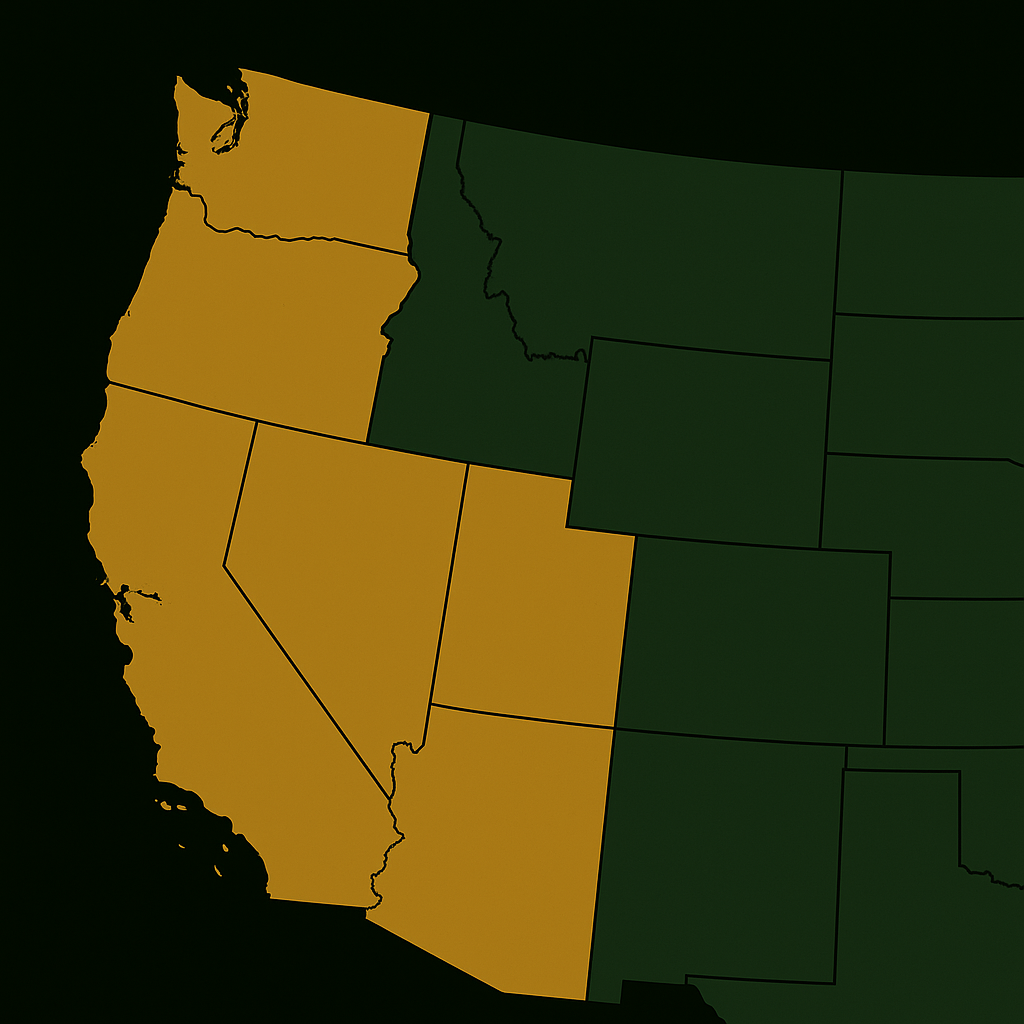
Towering mountain ranges, dense conifer forests, and rugged alpine valleys define the Western High Country and Inland Northwest, a region known for its demanding hunts and extraordinary biodiversity. Hunters visiting this zone encounter steep terrain and dynamic weather, but are rewarded with opportunities to pursue some of the most iconic western big game species in North America.
Steep ridgelines, alpine meadows, and remote timber basins make this region a haven for mountain hunting and trophy big game pursuits. The Western High Country and Inland Northwest host legendary species that require physical endurance, glassing precision, and often multi-day pack-in hunts. From dense forested slopes to open subalpine zones, this area is a prime destination for those seeking Rocky Mountain elk, black bear, bighorn sheep, and more—many of which contribute directly to official hunting slams.
Perhaps the most iconic species of this region, Rocky Mountain elk inhabit dense conifer forests and open meadows from Idaho to Montana. Bugling bulls and rugged terrain define the fall rut season.
Western mule deer roam high sage ridges, mixed timber zones, and steep draws. Known for their large frames and deep forks, they are a top target during both archery and rifle seasons.
Though more common in the eastern U.S., whitetails have strong populations in riparian corridors and valley bottoms throughout Montana and Idaho, especially in agricultural fringe zones.
One of North America’s most prestigious game animals, these sheep inhabit rocky cliffs and alpine crags. Tags are limited, and the hunt is often a once-in-a-lifetime pursuit tied to the Ovis World Slam.
The Inland Northwest holds excellent numbers of color-phase black bears. Spot-and-stalk opportunities abound in spring and fall seasons across forest openings and berry-rich drainages.
Apex predators of this region, mountain lions are pursued primarily with hounds in winter. Their stealth, size, and elusive behavior make them a challenging and rewarding quarry.
This upland species thrives in ponderosa pine forests and canyon draws. Known for their striking white-tipped tail feathers, Merriam’s turkeys are a highlight of spring hunts in high-elevation habitats.
From river valleys to alpine clearings, the Inland Northwest provides a rich mix of small game and upland species that extend hunting opportunities beyond traditional big game seasons. Whether you’re flushing ruffed grouse through conifer thickets or scanning the sky for migratory ducks over marshy basins, this region delivers a broad spectrum of accessible and rewarding pursuits. These species are ideal for introducing new hunters, enhancing multi-species trips, or expanding your annual harvest across the western hunting calendar.
These agile upland birds inhabit dense forests and moist drainages, offering close-range shooting and flush-and-fire excitement throughout fall.
Often found along forested ridgelines and open glades, dusky grouse are a high-country favorite and present a quiet, solitary challenge for backcountry hunters.
These fast-moving hares change coat color with the seasons and can be hunted throughout much of the region’s wooded terrain, particularly in winter.
Common in coniferous forests, red squirrels are quick, vocal, and offer a small but entertaining pursuit with rimfire rifles or light gauge shotguns.
Found in river systems, sloughs, and beaver ponds, mallards are the backbone of fall waterfowl hunts across Montana and Idaho.
Preferring secluded wetland pockets and forested swamps, wood ducks add color and challenge to early-season duck outings.
Abundant during migration windows, teal zip through valley marshes and are known for their speed and erratic flight paths.
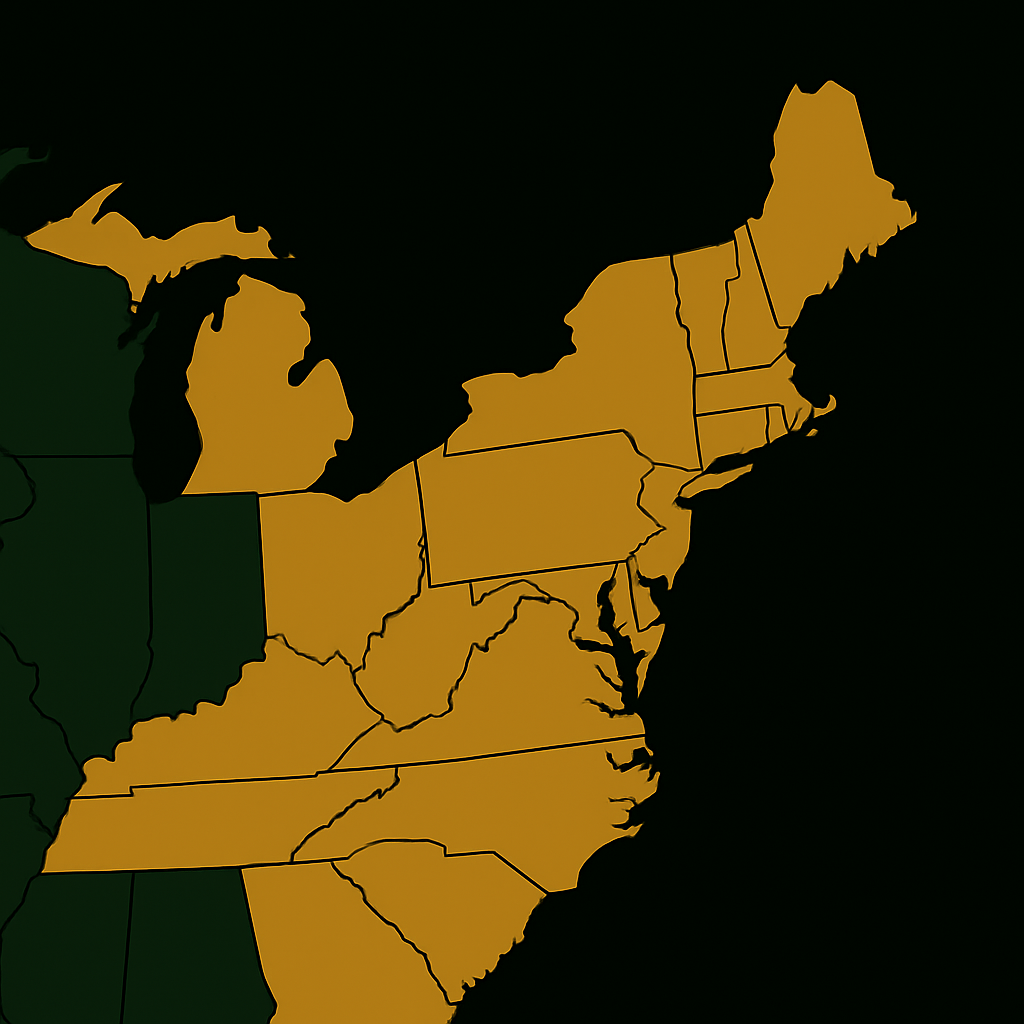
Dense hardwood forests, rolling ridges, and historic hunting traditions define the Northeast and Appalachian region. This area offers a rich blend of game diversity, combining iconic Eastern whitetails with upland birds and small game species, making it a well-rounded destination for hunters focused on woodland species and classic American pursuits.
The Northeast and Appalachian region offers a traditional yet dynamic hunting environment, defined by dense hardwood forests, seasonal changes, and a deep-rooted sporting culture. Here, hunters encounter iconic eastern whitetails, elusive black bears, and forest-dwelling wild turkeys, all within terrain that demands patience and precision. This region is ideal for pursuing woodland game species.
The most iconic species of the eastern U.S., whitetail deer are widespread across the Northeast. They inhabit mixed forests, farmland edges, and transitional habitats, offering both archery and rifle hunting opportunities.
These bears inhabit dense mountain forests and valleys throughout Appalachia and New England. Spot-and-stalk opportunities vary by state, with fall seasons offering high success in acorn-rich terrain.
The Eastern subspecies of wild turkey is known for its wary nature and deep gobble. Found throughout forested ridges and creek bottoms, it is a cornerstone species of the region’s spring hunting tradition.
Though technically a predator, coyotes are legally huntable across most of the Northeast and Appalachians. Their adaptability and expanding range make them a year-round challenge.
In managed zones across Pennsylvania, New York, and parts of New England, mature bucks can reach impressive size. These areas are popular for those chasing personal trophy benchmarks.
Though primarily black, occasional cinnamon or brown phase bears appear in northern areas, adding rarity to an already challenging pursuit.
The Eastern Forests offer more than just big game. Hunters can enjoy a wide array of small game and upland bird species that complement traditional deer and bear hunts. From the fast-paced flush of ruffed grouse to the stealth required for cottontail rabbit or gray squirrel, this region provides accessible and rewarding opportunities throughout the fall and winter seasons. These species are perfect for introducing new hunters, extending active seasons, and diversifying your experience across the Appalachian hunting landscape.
A classic upland game bird of the Northeast, ruffed grouse thrive in regenerating forests and brushy thickets. They offer quick, explosive flushes and are often hunted without dogs.
Common in wet woodland habitats, especially during migration. Known for their erratic flight and soft flush, they are a favorite among traditional bird hunters.
Found in dense underbrush and field edges, these rabbits offer action-packed winter hunts, often pursued with beagles or through still-hunting.
A staple of Eastern woodlands, gray squirrels are abundant and provide an excellent way to hone marksmanship and woodsmanship skills.
This clever predator is legal game in most of the region and can be pursued by calling or still-hunting. Its pelt remains a traditional prize in the Northeast.
Present in northern reaches, especially New England. Their white winter coat offers natural camouflage and exciting hunting challenges in snowy terrain.
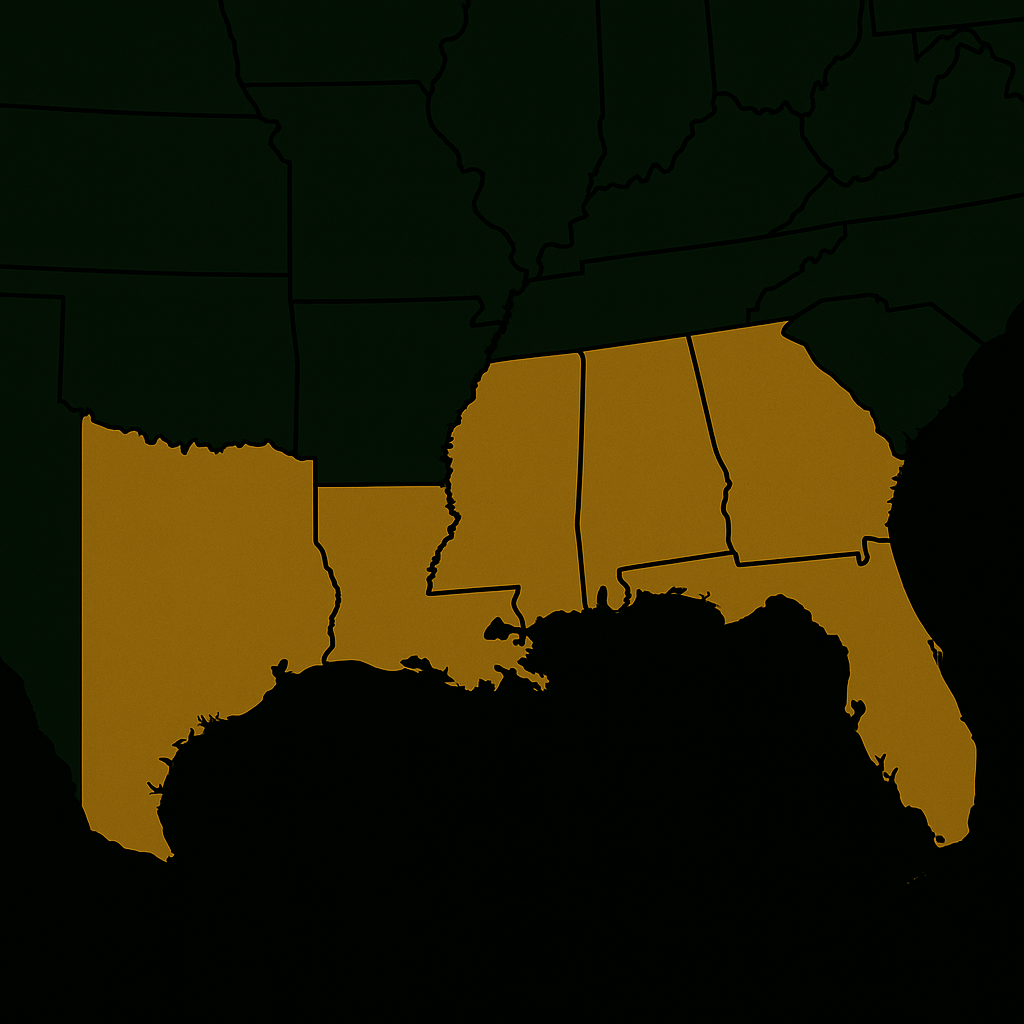
Southeastern woodlands, coastal marshes, and expansive river deltas form one of the most biologically diverse hunting zones in North America. The Southeast & Gulf Coast region offers year-round hunting opportunities for a wide array of big game, small game, upland birds, and waterfowl.
Across the pine-covered uplands, bayous, and river bottoms of the southeastern United States, hunters find some of the most accessible and diverse big game species in North America. This region supports strong populations of white-tailed deer, wild hogs, and black bears, each contributing to regional slam achievements and offering varied opportunities through traditional hunting styles like dog-led pursuits and archery seasons. The combination of terrain and climate ensures nearly year-round action, making the Gulf Coast hunting corridor especially attractive for those seeking both trophy-class animals and consistent harvest potential.
The most widely pursued species in the South, whitetail deer thrive in pine forests, agricultural corridors, and bottomland hardwoods. Long seasons and generous bag limits make this a foundational species for southern hunters.
Highly adaptable and present year-round, wild hogs are found across the entire Southeast and Gulf Coast. They offer dynamic, close-range hunts and are often pursued with dogs, thermal scopes, or archery equipment.
Although highly regulated, black bear populations in states like Florida and eastern North Carolina are expanding. Hunts are typically limited and quota-based but represent a prestigious and challenging pursuit.
A staple of southern spring hunting traditions, Eastern wild turkeys inhabit hardwood ridges, open fields, and coastal flats. Known for their sharp eyesight and powerful gobble, they offer exciting calling hunts.
In states like Florida, Louisiana, and Georgia, regulated alligator hunts are a unique draw. These hunts typically require specialized gear and tags but deliver memorable, high-adrenaline experiences.
Though non-native, axis deer are firmly established in South Texas and the lower Gulf region. They offer year-round hunting opportunities and are known for their striking coats and excellent meat quality.
In addition to its well-known big game, the Southeast offers a rich mix of complementary game species ideal for hunters seeking more varied or seasonal experiences. From classic southern dove hunts to swampy marsh pursuits of ducks and waterfowl, this region supports a wide range of small game opportunities that extend well beyond the fall rut. The presence of rabbits, squirrels, raccoons, and bobwhite quail provides an excellent entry point for new hunters and sustains active seasons year-round. Whether with dogs, shotguns, or bows, these species reflect the Southeast’s deep-rooted hunting traditions and are essential for those seeking complete and dynamic southern hunting experiences.
A classic target of Southern opening-day hunts, doves are abundant across farmland and field edges. Fast-paced shooting and social traditions define this experience.
Common in brushy cover and agricultural edges. Often hunted with dogs or through still-hunting, especially during winter.
Widespread in hardwood forests. Ideal for beginner hunters and for honing marksmanship in the woods.
Once abundant, now often pursued on managed lands. Known for explosive flushes and deep Southern cultural significance.
Favored for early morning hunts in swamps, sloughs, and flooded timber. Highly prized among waterfowlers for beauty and flavor.
A nocturnal challenge, often pursued with hounds. Still popular across the Southeast as a traditional, dog-driven hunt.
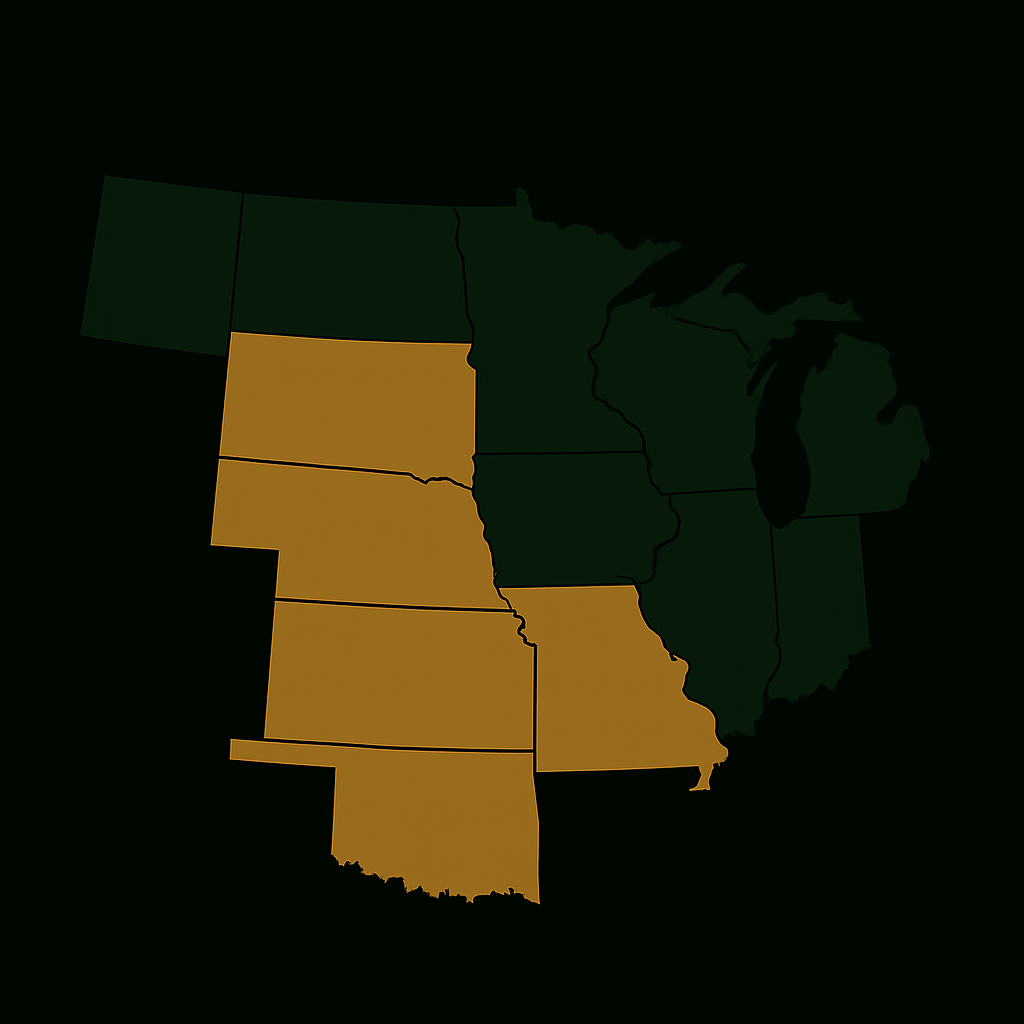
Stretching across vast open prairies, rolling hills, and fertile farmlands, the Midwest & Great Plains region delivers a classic North American hunting experience. Renowned for its population of iconic game animals and structured hunting seasons, this area caters to both resident hunters and traveling sportsmen seeking consistent success.
Dominated by expansive grasslands, fertile farmland, and patchwork woodlots, the Midwest and Great Plains offer some of the most productive big game hunting in North America. This region is a stronghold for whitetail deer, known for producing world-class trophies, as well as mule deer and pronghorn antelope across open rangelands. Consistent seasons, defined harvest quotas, and accessible private lands make it a top destination for hunters pursuing reliable success and diverse experiences. Whether chasing deer during the rut or spotting pronghorn in wide-open vistas, these trophy animals represent the heart of Midwestern hunting tradition.
The Midwest is widely considered the top region in the world for trophy-class whitetail bucks. Agricultural fields, river bottoms, and woodlots create ideal conditions for mature deer to thrive.
Western portions of the Great Plains provide prime habitat for mule deer, especially in open rangelands, badlands, and canyon edges. Spot-and-stalk is the most common tactic.
Abundant across the central and western plains, pronghorn are known for their sharp vision and incredible speed. Popular for archery and rifle hunts across open terrain.
Several states offer limited but regulated bison hunts on public and private lands. These animals are symbolic of the plains and represent a rare opportunity for a unique North American trophy.
The region supports excellent spring turkey seasons, with both Eastern and Rio Grande subspecies thriving in farmland and mixed forest habitats.
Beyond big game, the Central Heartland supports a wide variety of complementary hunting species that contribute to its year-round appeal. From classic pheasant and quail hunts in open fields to abundant populations of cottontail rabbits and gray squirrels in wooded areas, this region offers dynamic options for hunters of all ages and experience levels. Whether you’re introducing newcomers to the sport or extending your season beyond peak deer rut, these small game opportunities maintain strong cultural and recreational value across the Midwest.
Thriving in agricultural landscapes, pheasants are iconic in the Midwest. Known for explosive flushes and colorful plumage, they’re often pursued with dogs in open grasslands and field edges.
Found in native grasslands and brushy cover, bobwhite quail are popular upland targets, valued for their fast, erratic flight and cultural significance in traditional field hunts.
Widespread across farms and field edges, these rabbits provide high-action hunts, especially in winter. Commonly pursued with beagles or via still-hunting methods.
Abundant in hardwood patches and shelterbelts throughout the region. Squirrels offer excellent early-season action and help younger hunters develop woodland skills.
Once widespread, this species is now hunted primarily in specific areas like Kansas or Nebraska. Regulated seasons exist, offering a rare upland opportunity in the Great Plains.
Legally huntable across much of the Midwest, especially with hounds at night. Still considered a traditional pursuit in rural areas.
International hunting offers a rich and diverse spectrum of game species distributed across continents, from the plains of Africa to the alpine ranges of Europe and the vast wilderness of Asia and South America. Understanding which species are legally huntable—and where—is essential for collectors, conservation-focused sportsmen, and those pursuing multi-species achievements. Whether you’re planning your next expedition or simply researching regional biodiversity, tools like our app for hunters provide critical support to log trophies, track progress, and explore opportunities by region.
Africa is home to some of the most iconic and challenging game animals in the world. Many of these species are part of official slams in Africa, which reward hunters who pursue structured multi-species goals across the continent.
Species like lion, elephant, or kudu often appear in more than one slam category, making them key objectives for serious collectors tracking their achievements through Africa’s rich and diverse hunting landscape.
Symbol of strength and one of the most coveted trophies on the continent. Part of the African Big Five.
Known for its unpredictable behavior and powerful build; a classic pursuit in African safaris.
The largest land mammal, legal to hunt only under strict regulations in specific regions.
Elusive and challenging, hunted through baiting or tracking, often at night.
Highly regulated and rare; pursued under conservation frameworks.
Recognized for its majestic spiral horns; key target for Spiral Horn hunters.
Striking in appearance and highly prized among plains game species.
Widespread and graceful, often the first African game species pursued by international hunters.
A unique antelope with a distinctive head shape and impressive endurance.
→ Explore species in the Spiral Horn Slam
→ Meet the Big Five species
From the alpine peaks to the Mediterranean forests, Europe hosts a vast variety of huntable species that appeal to both traditional and modern hunters. These animals often reflect deep cultural roots in the region’s hunting heritage.
including species that are prized for their rarity, appearance, or challenge. European game is not only about majestic stags and wild boars—it’s also about selective pursuits conservation practices and trophy quality standards.
The most iconic European game animal, pursued in nearly every country across the continent.
Small and elusive, native to forests and fields throughout Central and Eastern Europe.
Recognizable by their palmate antlers, commonly hunted in Southern and Western Europe.
Present across the continent; valued for both meat and trophy tusks.
Agile mountain goat-antelope hybrid found in the Alps, Pyrenees, and Carpathians.
European wild sheep with impressive spiral horns, especially present in Mediterranean regions.
A challenging mountain species restricted to specific alpine zones under strict quotas.
Found in Eastern Europe and Russia, slightly larger than its Western counterpart.
A prized upland bird in Scandinavia and the Balkans, known for its display and rarity.
Legally hunted in countries like Romania and parts of the Balkans under conservation systems.
Spanning vast deserts, towering mountains, and remote highlands, Asia is home to some of the most challenging and prestigious trophy species in the world. From wild sheep in Central Asia to elusive ibex in the Middle East, these hunts require expert guidance, endurance, and careful planning.
Whether you pursue them as part of global slam goals or individual milestones, the species found here are essential to some of the most demanding hunting achievements worldwide.
Legendary high-altitude wild sheep native to the Pamir Mountains, prized for its massive spiraled horns.
Found in Mongolia and parts of Siberia; among the largest-bodied sheep in the world.
The most widespread ibex species in Central Asia, pursued across rugged and remote terrain.
A rare and challenging mountain sheep endemic to the Tien Shan range.
Native to southern Pakistan, known for its striking horn shape and desert habitat.
A tough species adapted to harsh, arid mountain conditions in the Gobi region.
Wild sheep native to dry hills and deserts; targeted in Pakistan and parts of Central Asia.
Widespread in Eastern Russia and parts of Kazakhstan, larger than its European counterpart.
Legally hunted in limited regions, particularly in the Russian Far East.
Found across many Asian countries, offering accessible and traditional hunts in forested regions.
→ Discover the official hunting slams across Asia’s mountain ranges
→ Learn more about the legendary Marco Polo Argali and its hunting challenges
Rainforests, highland steppes, and arid pampas make South America one of the most ecologically diverse hunting destinations. While the continent lacks formal slam structures, it offers high-value species that attract international hunters seeking exotic trophies and immersive expeditions.
From the elegant red stag introduced in Patagonia to native species like water buffalo and collared peccary, these hunts are both culturally rich and biologically distinct.
Introduced in Argentina and Chile; now a premier trophy species across Patagonia.
Non-native but established in regions like northern Argentina and Uruguay; valued for spotted coat and antler symmetry.
Common in marshlands and wetlands, especially in Argentina; hunted for size and difficulty.
Indigenous to South America; challenging and often pursued in dense jungle or brush.
The world’s largest rodent, legally hunted in select areas; offers a unique and exotic experience.
Small, elusive forest deer found across the Amazon basin and Andean foothills.
Present in agricultural zones; valued for meat and tusk trophies.
Legally hunted in controlled areas of Argentina and Chile.
Large, aquatic-adapted deer found in the Pantanal and northeastern Argentina.
→ Explore hunting opportunities and exotic big game species in South America
→ Discover top South American game species and where to hunt them
🟨 For Beginners
A hunting species list is a structured inventory of game animals that can be legally pursued in specific regions. It helps new hunters understand local regulations, plan safer hunts, and discover which species are available for hunting in different ecosystems.
Typical big game animals include species like elk, moose, bear, and deer. These are often part of slam-related hunting achievements and are valued for their size, difficulty, and conservation role.
Legal status varies by country and region. A legal game animal is one that can be hunted under government regulation during specific seasons, often with permits. This list organizes them clearly by location and category.
Yes. A categorized hunting species list helps you align your goals with species availability, especially when starting out. You can choose between upland birds, small game, or entry-level big game depending on your experience and location.
🟧 For Experienced Hunters
Many multi-species hunting goals, such as the North American Grand Slam or the African 29, require pursuing specific animals in certain regions. This game animals list aligns with official slam requirements, helping you plan efficiently.
Absolutely. We feature exotic hunting species like aoudad, axis deer, water buffalo, and other non-native but legally huntable animals—ideal for collectors or international expeditions.
Trophy-class animals are those that meet specific standards in size, antler/horn measurement, or rarity. They’re usually the target of trophy hunting expeditions and often contribute to hunting records or personal slams.
Yes. The list is organized for flexible browsing—whether by habitat type (e.g., alpine, desert, forest), species group (e.g., predators, ungulates), or geographic region. Additionally, if you’re using a specialized hunting app, you can track these species digitally, link them to personal goals or slams, and optimize your planning with real-time filters and data.
You can explore curated trophy species lists for each region, giving you access to localized hunting opportunities with trusted outfitters, species availability, and slam relevance.
Accessing a complete and categorized hunting species list is essential for planning successful expeditions and understanding the full range of trophy-class animals available worldwide. This list includes both traditional big game species and less common huntable wildlife, organized by environment, animal type, and region. Whether you’re researching game animals by habitat, seeking exotic species for trophy hunting, or preparing for multi-species hunting achievements, this reference connects you to legally recognized huntable species. It also supports those tracking progress across hunting slams, offering a regional breakdown of game animals that reflect ethical and strategic hunting goals. By comparing trophy species lists from different ecosystems, hunters can identify the right opportunities and plan smarter, more responsible pursuits.
Legal Policy